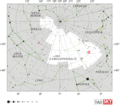| Emission nebula | |
|---|---|
| Planetary nebula | |
 As seen from the Hubble Space Telescope As seen from the Hubble Space Telescope | |
| Observation data: J2000 epoch | |
| Right ascension | 04 06 59.39 |
| Declination | +60° 55′ 14.4″ |
| Distance | est. 4,240 ly (1.30 kpc) ly |
| Apparent magnitude (V) | 13.0 |
| Apparent dimensions (V) | 0.863' (diameter) |
| Constellation | Camelopardalis |
| Physical characteristics | |
| Radius | 0.5 ly |
| Designations | PK 144+6.1, PN G 144.5+06.5, GC 801, CS 14.4, H 4.53 |
| See also: Lists of nebulae | |
NGC 1501 (also known as the Camel's Eye Nebula or the Oyster Nebula) is a complex planetary nebula located in the constellation of Camelopardalis, it was discovered on 27 August 1787 by William Herschel.
Properties
The central star of the planetary nebula has a spectral type of , similar to that of a carbon-rich Wolf–Rayet star. It is a pulsating star, meaning that its brightness varies regularly and periodically. In the case of NGC 1501's progenitor star, this is incredibly fast, with the star's brightness changing significantly in just half an hour. An analysis of Gaia data suggests that the central star is a binary system. Visible-light observations capture the glow of gases including hydrogen and nitrogen. The total mass of the nebula is estimated to be around 0.22 M☉, most of which is ionized gas (0.21 M☉) and a small fraction (8.9×10 M☉) is carbon-rich dust.
Gallery
-
 The location of NGC 1501 (circled in red)
The location of NGC 1501 (circled in red)
-
 NGC 1501 from the 0.8m Schulman Telescope at the Mount Lemmon SkyCenter
NGC 1501 from the 0.8m Schulman Telescope at the Mount Lemmon SkyCenter
References
- ^ "SIMBAD Astronomical Database". NGC 1501. Retrieved 9 November 2014.
- ^ Sabbadin, F.; Benetti, S.; Cappellaro, E.; Turatto, M. (2000). "The tetra-lobed planetary nebula NGC 1501". Astronomy and Astrophysics. 361: 1112–1120. arXiv:astro-ph/0007039. Bibcode:2000A&A...361.1112S.
- Stoyan, Ronald; Schurig, Stephan (2014). interstellarum Deep Sky Atlas. Erlangen: Cambridge University Press; Oculum-Verlag GmbH. ISBN 978-1-107-50338-0. OCLC 920437579.
- "Hubble View of Bubbly Nebula". 17 April 2015. Retrieved 8 December 2016.
- Seligman, Courtney. "Celestial Atlas: NGC Objects: NGC 1500 - 1549". cseligman.com. Archived from the original on 1 January 2016. Retrieved 10 July 2015.
- González-Santamaría, I.; Manteiga, M.; Manchado, A.; Ulla, A.; Dafonte, C.; López Varela, P. (2021). "Planetary nebulae in Gaia EDR3: Central star identification, properties, and binarity". Astronomy & Astrophysics. 656: A51. arXiv:2109.12114. Bibcode:2021A&A...656A..51G. doi:10.1051/0004-6361/202141916. S2CID 237940344.
- Chornay, N.; Walton, N. A.; Jones, D.; Boffin, H. M. J.; Rejkuba, M.; Wesson, R. (2021). "Towards a more complete sample of binary central stars of planetary nebulae with Gaia". Astronomy & Astrophysics. 648: A95. arXiv:2101.01800. Bibcode:2021A&A...648A..95C. doi:10.1051/0004-6361/202140288. S2CID 230770301.
- "Oyster Nebula NGC 1501 As Seen By Hubble - SpaceRef". spaceref.com. 7 September 2016. Retrieved 8 February 2021.
- Rubio, G.; Toalá, J. A.; Todt, H.; Sabin, L.; Santamaría, E.; Ramos-Larios, G.; Guerrero, M. A. (2022). "Planetary nebulae with Wolf–Rayet-type central stars – IV. NGC 1501 and its mixing layer". Monthly Notices of the Royal Astronomical Society. 517 (4): 5166–5179. arXiv:2210.09116. Bibcode:2022MNRAS.517.5166R. doi:10.1093/mnras/stac3011.
External links
 Media related to NGC 1501 at Wikimedia Commons
Media related to NGC 1501 at Wikimedia Commons- http://www.astronomy-mall.com/Adventures.In.Deep.Space/abellcat
- http://www.observing.skyhound.com/archives/dec/NGC_1501
| Constellation of Camelopardalis | |||||||||||||
|---|---|---|---|---|---|---|---|---|---|---|---|---|---|
| Stars |
| ||||||||||||
| |||||||||||||
| |||||||||||||
| |||||||||||||
| Galaxies |
| ||||||||||||
| |||||||||||||
| |||||||||||||
This nebula-related article is a stub. You can help Misplaced Pages by expanding it. |